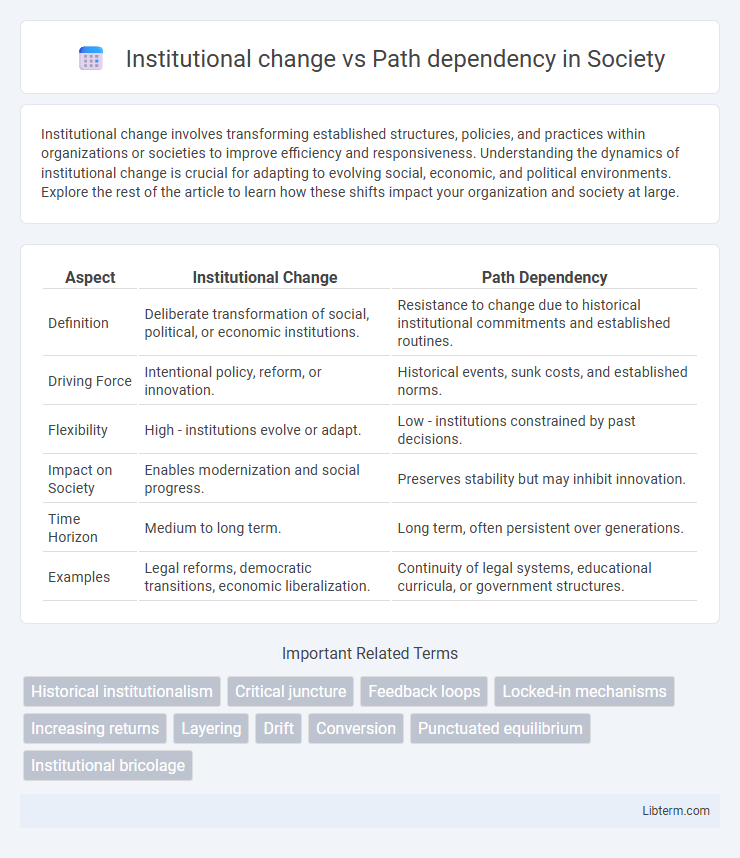Institutional change involves transforming established structures, policies, and practices within organizations or societies to improve efficiency and responsiveness. Understanding the dynamics of institutional change is crucial for adapting to evolving social, economic, and political environments. Explore the rest of the article to learn how these shifts impact your organization and society at large.
Table of Comparison
| Aspect | Institutional Change | Path Dependency |
|---|---|---|
| Definition | Deliberate transformation of social, political, or economic institutions. | Resistance to change due to historical institutional commitments and established routines. |
| Driving Force | Intentional policy, reform, or innovation. | Historical events, sunk costs, and established norms. |
| Flexibility | High - institutions evolve or adapt. | Low - institutions constrained by past decisions. |
| Impact on Society | Enables modernization and social progress. | Preserves stability but may inhibit innovation. |
| Time Horizon | Medium to long term. | Long term, often persistent over generations. |
| Examples | Legal reforms, democratic transitions, economic liberalization. | Continuity of legal systems, educational curricula, or government structures. |
Understanding Institutional Change
Understanding institutional change requires analyzing the mechanisms by which established norms, rules, and practices shift over time despite the persistence of path dependency. Institutional change often emerges from internal pressures such as shifts in power dynamics or external shocks like economic crises that disrupt existing equilibria, enabling new arrangements to take hold. Path dependency emphasizes the role of historical trajectories and increasing returns, highlighting how past decisions constrain current institutional flexibility, making change complex and nonlinear.
Defining Path Dependency
Path dependency refers to the idea that institutional decisions and outcomes are heavily influenced by historical events and previous choices, creating a self-reinforcing process that limits alternatives. This concept highlights how initial conditions and critical junctures set patterns that shape the trajectory of institutions, making change difficult and gradual. Institutions become locked into certain paths due to increasing returns, coordination effects, and sunk costs, reinforcing stability over time despite external pressures.
Historical Roots of Path Dependency
Historical roots of path dependency reveal how initial institutional decisions create self-reinforcing mechanisms that limit future policy options and maintain established trajectories. These early choices embed norms, routines, and power structures within institutions, making change costly and complex. Institutional change often requires overcoming these entrenched patterns that have developed over extended periods, reflecting deeply rooted historical contingencies.
Mechanisms Driving Institutional Change
Mechanisms driving institutional change include external shocks, shifting power dynamics, and evolving preferences of stakeholders, which disrupt existing path-dependent trajectories. Path dependency emphasizes how initial conditions and self-reinforcing processes create institutional lock-in, making change slow and resistant. Understanding the balance between exogenous triggers and endogenous reinforcement clarifies the complex dynamics shaping institutional evolution.
Factors Reinforcing Path Dependency
Factors reinforcing path dependency include increasing returns, where the benefits of following established institutions grow over time, making change costly and less attractive. Complementary investments in technology, skills, and infrastructure further solidify existing institutional frameworks, creating high switching costs. Additionally, cognitive biases and social norms embed institutional choices deeply, reducing the likelihood of disruptive institutional change.
Case Studies: Institutional Change in Practice
Case studies of institutional change illustrate how entrenched path dependency often shapes organizational behaviors and policy decisions over time, creating resistance to reform. Examples from sectors like healthcare and education reveal that successful institutional change requires strategic interventions such as coalition-building, adaptive leadership, and the leveraging of windows of opportunity to disrupt established routines. Empirical evidence from these case studies highlights the dynamic interplay between historical legacies and agents of change in reshaping institutional norms and practices.
Breaking Free from Path Dependency
Breaking free from path dependency requires intentional institutional change that disrupts entrenched routines and self-reinforcing mechanisms sustaining the status quo. Strategic interventions such as policy reforms, shifts in governance structures, and innovation adoption can alter historical trajectories and unlock new developmental pathways. Overcoming institutional lock-in demands adaptive leadership and coordinated efforts to challenge existing power dynamics and promote transformative change.
The Interplay of Structure and Agency
Institutional change often occurs through the dynamic interplay between structure and agency, where existing institutional frameworks constrain individual actions while simultaneously being reshaped by those actors. Path dependency emphasizes how historical decisions and established practices create enduring constraints that limit the scope for radical change, reinforcing stability within institutions. Understanding this interaction highlights the tension between the persistence of institutional structures and the capacity of agents to enact transformative change over time.
Challenges in Achieving Institutional Change
Achieving institutional change faces significant challenges due to path dependency, where established norms, routines, and vested interests create resistance to innovation. Institutions are often reinforced by existing power structures and resource allocations, making deviation costly and complex. Overcoming these barriers requires strategic interventions that address both the inertia of historical trajectories and the embedded interests sustaining the status quo.
Policy Implications: Navigating Change and Continuity
Institutional change involves deliberate reforms that reshape governance structures, while path dependency emphasizes the persistence of established policies due to historical constraints. Policy implications require balancing innovation with the recognition of entrenched frameworks to avoid resistance and inefficiencies. Effective navigation demands adaptive strategies that integrate incremental shifts within existing institutional trajectories to promote sustainable development.
Institutional change Infographic

 libterm.com
libterm.com